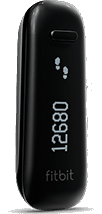Here's the one problem with wearables that we all need to fix


Back in January this year, I bought a Fitbit One. If you don't know what that is, I'll explain. It's a little one-inch-by-half-an-inch slug of black plastic that measures how active you are.
You carry it on you and it keeps track of how much you walk, move about, etc. You can even wear it at night and it'll track the amount and quality of your sleep.
It is really cool, but I used it for about a month and then lost interest. At the time, I was in traditional "lazy geek" mode -- i.e. I wasn't getting much exercise and I felt pretty neutral about the benefit it was providing.
However, about eight weeks ago I got a place on next year's London Marathon, so I've been a bit more interested in keeping track of my activity and I've started using it again.
And then I lost it. In the sense that I had a Fitbit, and then I didn't have one any more.
Which got me to thinking about a problem with wearables.
Tiny
At the moment, I use (wear?) two wearable devices -- a Pebble smartwatch, and the erstwhile Fitbit.
The only frustration with the Pebble is that I keep forgetting to charge it. But at least I actually strap it onto me. Not so much with the Fitbit, which just has to live in one of my pockets. It's so small and light that it's easy to lose. If my keys fell out of my pocket, I'd notice that. If my Fitbit did -- no chance.
Case in point, it might be the case that you sit down in McDonalds with a Fitbit, smartphone, keys, and wallet, and then you get home you discover that you no longer have a Fitbit.
Wearables necessarily need to be small and light, otherwise no one is going to want to wear them. They have to be forgettable, which increases the chance that you can forget them.
Wearables have a lot of problems that need to be overcome -- the most important being the issue making them compelling and useful to ordinary people doing ordinary things. (The Fitbit does do a rather good job of that, to be fair.) But the problem of safeguarding any investment such that the careless owner (me in this instance) doesn't keep losing them surely has to be up there.
Just in case the outcome of what happened to my Fitbit is causing you too much emotional discomfort, shall I tell you where I found it? It wasn't in McDonald's -- despite me going back with an iPad trying to make it sync, a bit like how back in the olden times we used to do water divination with a stick. It was actually at home, under a pile of other stuff. I hadn't lost it at all. Don't ask.
Swallowables?
"Quantified self" devices, like the Fitbit, divide themselves into a number of groups. Some of those groups need light in order for them to be functional. A smartwatch needs to be seen so that you can read its display. A lifelogging device, like Narrative, need to see what's around it so that it can take photos.
If it doesn't need light, why not swallow it? (Do I need to say, "don't try this at home"?) That approach is highly convenient to begin with, but if you follow it to it's, uh, natural conclusion you may either have an issue with the constituent rare earth metals ending up in the sewage system, or you may have an issue with stopping the constituent rare earth metals from ending up in the sewage system.
If you don't fancy swallowing it, why not fit your wearable subdermally? Sure, you'd need to have a little surgical procedure, but from there it'd be easy to charge (think conductive charging like Qi charging pads), and easy to get data from it (think Bluetooth Low Energy).
Let's assume those ideas are a way off, is there anything you can do today to keep your "unattached wearables" with you at all times?
There are in the market today a tonne of products that offer to keep your stuff around you -- the idea being that you attach some form of tag and you'll either be alerted if they go outside of a given range. Kensington's Proximo Proximity Monitoring System is one system; the crowdsourced Tile is another.
But the obvious problem with both of these is that they are too big. The tags associated with both of those systems are way bigger than my Fitbit.
An answer
Is there a possible software answer to all this? I think there is.
The Proximo system that I mentioned above works by attaching physical tokens to things that you want to keep in range. That presupposes that what you want to keep isn't an active device. Put more simply, your keys, bag, teddy bear, etc don't run Bluetooth.
Virtually every wearable technology does and will continue to do so going forward. So why not create a software standard for tracking wearable devices? Why do we need to have all this clever widgetry when all you need is an app together with some agreed way for all these devices to behave?
I should just be able to buy a Pebble, or a Fitbit, or a Narrative, or a whatever and the app and devices work together to stop me from losing stuff.
What I want though is not one set of options in the Pebble sync app, another in the Fitbit sync app, and so on. I want it either standardised in the smartphone OS, or as an app that acts as a standard.
It's not rocket science. Unless you're using it track parts for a rocket, in which case it may be.
What do you think? Post a comment, or talk to me on Twitter: @mbrit.